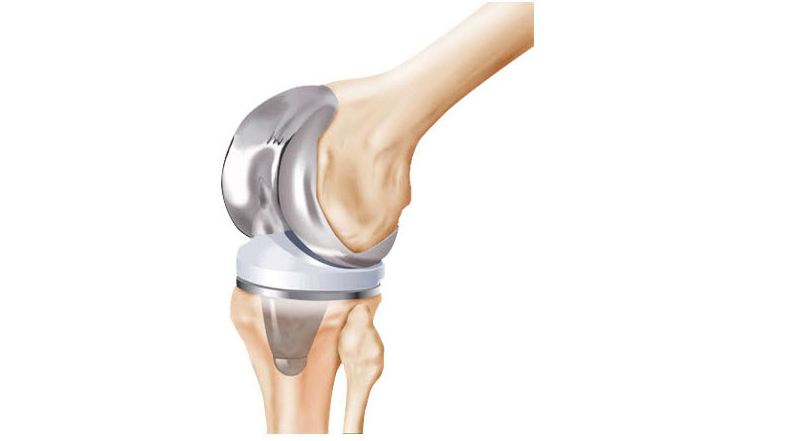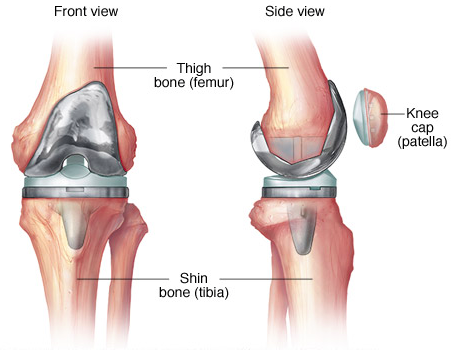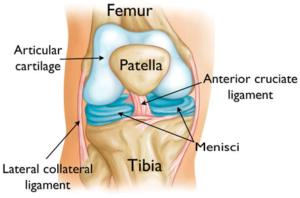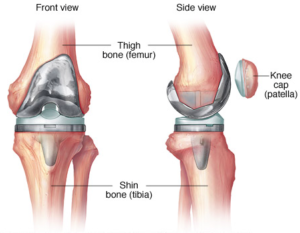Note: This article contains many anatomical terms that were identified in a previous article, “What is Total Knee Replacement.”
Many orthopedic device manufacturing companies exist, and many of them design and produce unique total knee replacement (TKR) products. The unique characteristics of each implant set it apart from other models within the company and within the industry. This article will identify 7 characteristics of knee replacement products and define terminology to explain the different products.
Fixed Bearing and Mobile Bearing
1. The fixed bearing implant is a more traditional type of knee implant that is designed with less active patients in mind. This implant is termed “fixed bearing” because the plastic surface is “fixed” into the tibial component, only allowing for front-and-back knee movement, meaning the implant is not designed to allow for pivoting or twisting movement about the knee joint.
2. The mobile bearing implant is a more complex design that is made for more active patients. It is termed “mobile bearing” because the plastic surface is attached to the tibial component in a way that allows for pivoting and twisting of the knee joint, in addition to the standard front-and-back movement. This additional mobility results from the ability of the plastic to move on the tibial surface.
Fixation
Perhaps the most important characteristic of a knee implant is how the metal components adhere to the bones for fixation. There have been many product recalls in the orthopedic device world regarding this issue. The metal components can be attached to the bones in one of two ways: with cement or without.
3. The most common method of attachment is to use bone cement as a glue to properly adhere the metal to the bone. If the cement does not adhere properly, the metal components may become loose, which could cause severe pain along with a dysfunctional knee.
4. Advancements in material properties have led to the development of a cementless system of fixation. The special material used on these implants is a type of porous metal. Porous metal has holes (pores) in it that allow the bone to grow into the metal for proper attachment. Again, if the bone does not properly grow into the metal component, it may become loose; leading to pain and dysfunction.
Fate of the Ligaments
Additional characteristics regard the outcome of the ligaments of the knee. The medial collateral ligament (MCL) and lateral collateral ligament (LCL) are generally kept during the operation, so the discussion of whether to keep or remove the knee ligaments centers around the anterior cruciate ligament (ACL) and posterior cruciate ligament (PCL).
5. The traditional way of dealing with the ACL and PCL is to remove them, which would be called cruciate sacrificing. As discussed previously, the ligaments help to stabilize the knee joint, allowing for pivoting and twisting movements; once these ligaments are removed, pivoting and twisting becomes more difficult.
6. Through scientific advancements, a method for keeping the PCL has been developed in some models of knee implants; these models are called cruciate retaining. In some knee implants, a method has been developed to keep both the ACL and PCL during the operation; this model implant is termed a bicruciate retaining model.
7. Lastly, another type of knee implant is called posterior stabilized. This implant procedure removes both the ACL and PCL, but the implant is designed to mimic the actions of the PCL, which will stabilize the movements that would normally be stabilized by the PCL.
Conclusion
In this article, the main characteristics of total knee replacement products were identified. This includes fixed bearing, mobile bearing, cemented, non-cemented, cruciate sacrificing, cruciate retaining, bicruciate retaining, and posterior stabilizing.
Without being informed and asking your orthopedic physician the right questions, you could end up with a fixed bearing, cemented knee implant and your ligaments (ACL and PCL) removed without even knowing. Not that this type of implant would be harmful to you, but when considering a TKR, you should be aware of the options available to you and which models would best suit your lifestyle. Read here about shopping for knee replacement.
Sign up for the free newsletter and receive the 2017 Knee and Hip Replacement Price Report.
Always consult a doctor to discuss specific knee implants along with their characteristics and functionalities. The appropriate knee implant system for you should be chosen in accordance with your doctor.



